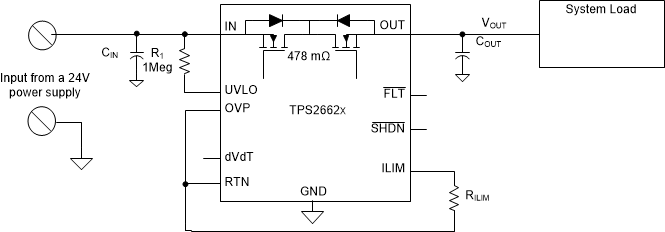SLVSDT4F October 2017 – December 2021 TPS2662
PRODUCTION DATA
- 1 Features
- 2 Applications
- 3 Description
- 4 Revision History
- 5 Device Comparison Table
- 6 Pin Configuration and Functions
- 7 Specifications
- 8 Parameter Measurement Information
-
9 Detailed Description
- 9.1 Overview
- 9.2 Functional Block Diagram
- 9.3
Feature Description
- 9.3.1 Undervoltage Lockout (UVLO)
- 9.3.2 Overvoltage Protection (OVP)
- 9.3.3 Hot Plug-In and Inrush Current Control
- 9.3.4 Reverse Polarity Protection
- 9.3.5 Overload and Short-Circuit Protection
- 9.3.6 Reverse Current Protection
- 9.3.7 FAULT Response
- 9.3.8 IN, OUT, RTN, and GND Pins
- 9.3.9 Thermal Shutdown
- 9.4 Device Functional Modes
-
10Application and Implementation
- 10.1 Application Information
- 10.2 Typical Application
- 10.3 System Examples
- 10.4 Do's and Don'ts
- 11Power Supply Recommendations
- 12Layout
- 13Device and Documentation Support
- 14Mechanical, Packaging, and Orderable Information
Package Options
Mechanical Data (Package|Pins)
- DRC|10
Thermal pad, mechanical data (Package|Pins)
- DRC|10
Orderable Information
10.3.2 Simple 24-V Power Supply Path Protection
With the TPS2662x, a simple 24-V power supply path protection can be realized using a minimum of four external components as shown in the schematic diagram in Figure 10-14. The external components required are: a 1Meg Ω R(1) resistor across IN and UVLO pins, a R(ILIM) resistor to program the current limit, C(IN) and C(OUT) capacitors.
 Figure 10-14 TPS2662x Configured for a Simple 24-V Supply Path Protection
Figure 10-14 TPS2662x Configured for a Simple 24-V Supply Path ProtectionProtection features with this configuration include:
- Load and device protection from reverse input polarity fault down to –60 V
- Upstream supply and device protection from reverse output polarity fault down to –(60 – VIN) V with TPS26624 and TPS26625 variants
- Protection from 60 V from the external SELV supply: overvoltage Clamp at 38 V with TPS26622 and TPS26623 variants
- Inrush current control with 24 V and 660-µs output voltage slew rate
- Reverse Current Blocking
- Accurate current limiting with auto-retry with TPS26621, TPS26623, TPS26625 variants
- Accurate current limiting with latch-off with TPS26620, TPS26622, TPS26624 variants